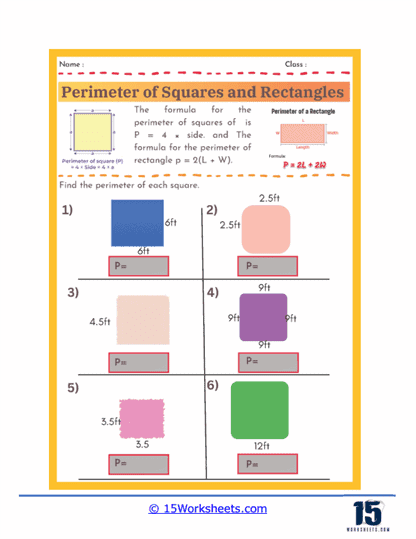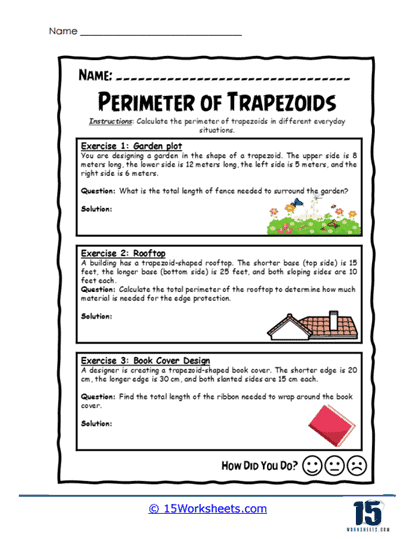Perimeter Worksheets
About Our Perimeter Worksheets
Perimeter is more than just a mathematical concept-it’s the key to unlocking a world of shapes, measurements, and real-life applications! From fencing a backyard to framing a picture, understanding how to calculate perimeter helps students connect math to everyday situations. Whether they’re just starting to explore simple rectangles or tackling complex polygons, grasping perimeter is an essential step in developing spatial awareness and problem-solving skills. And let’s be honest-who doesn’t love a good math challenge that makes them think outside the box (or around it, in this case)?
That’s where perimeter worksheets come in! These handy learning tools break down the process into manageable steps, making it easier for students to practice and master the skill. With guided examples, fun exercises, and real-world problems, worksheets transform what could be a tedious calculation into an engaging learning experience. Plus, they cater to different learning levels-whether a student needs basic practice with squares and rectangles or a more advanced challenge involving irregular shapes. And for those who love a bit of competition, why not turn it into a game? Who can find the perimeter the fastest? Who can solve the most challenging shape? Learning is always better with a little friendly rivalry!
The best part? These worksheets are available in convenient PDF format, making them accessible to students, teachers, and homeschoolers alike. No need to worry about lost papers or messy notebooks-just download, print, and start solving! Whether in the classroom, at home, or even on the go, perimeter practice is always within reach. So, whether you’re helping a young learner take their first steps in geometry or sharpening your own skills, these worksheets provide a fun and effective way to master perimeter-one shape at a time!
By using perimeter worksheets, learners can develop confidence in measuring boundaries, applying formulas, and understanding the significance of perimeter in daily life. These worksheets provide a progressive learning experience, helping students refine their skills from basic shapes to more complex geometrical figures.
Types of Shapes Covered in Our Perimeter Worksheets
Perimeter worksheets introduce students to a variety of shapes, each requiring a unique approach for calculation. This diversity ensures that learners gain a well-rounded understanding of the concept.
These worksheets involve finding the total boundary length of irregular or complex figures made by combining basic shapes. To calculate the perimeter, one must sum up the outer side lengths of all the individual shapes forming the composite figure. In real life, this is useful for determining fencing needs around an irregular yard or estimating materials for framing a custom-shaped garden.
Perimeter of Parallelograms and Rhombus
These worksheets focus on calculating the perimeter of parallelograms and rhombuses using formulas involving their side lengths. Since opposite sides of a parallelogram are equal, the formula is typically 2 × (base + side length), while for a rhombus, it is 4 × side length since all sides are equal. This is useful in construction when designing parallelogram-shaped floors, tiles, or window frames.
These worksheets require summing the lengths of all sides of any multi-sided closed figure, whether regular or irregular. The perimeter is found by adding each side’s length, which varies depending on the shape of the polygon. This applies to real-life scenarios such as measuring the border of a garden bed, designing a table covering, or fencing a uniquely shaped property.
These worksheets deal with four-sided shapes like squares, rectangles, trapezoids, and irregular quadrilaterals by adding up the lengths of all four sides. The method depends on whether the quadrilateral has equal sides or varying lengths. In practical use, this helps with framing paintings, installing borders around driveways, or constructing four-sided enclosures.
Perimeter of Squares and Rectangles
These worksheets focus on two of the most common geometric shapes, with formulas 4 × side length for squares and 2 × (length + width) for rectangles. These calculations are commonly used in home improvement projects such as determining the amount of trim needed for a room, measuring fencing for a rectangular yard, or laying tiles for a floor.
These worksheets involve adding the lengths of all four sides of a trapezoid, where at least one pair of opposite sides is parallel. The perimeter calculation is straightforward but can include solving for missing side lengths in some problems. Real-world applications include designing trapezoidal roofing structures, calculating the border of a table mat, or planning the frame for an irregular picture.
These worksheets focus on summing the three sides of different types of triangles, such as equilateral, isosceles, or scalene. The perimeter is simply the total of all side lengths, sometimes requiring the Pythagorean theorem for missing sides. This is useful in construction for measuring triangular roof supports, designing traffic signs, or calculating material for triangular park enclosures.
By offering a variety of shape-based exercises, perimeter worksheets provide students with comprehensive practice opportunities, ensuring they master the skill across different geometric figures.
What is Perimeter?
Perimeter is the total length of the outer boundary of a shape.
In simple terms, it is the sum of all the sides that enclose a space. Understanding perimeter is vital because it helps in measuring distances around objects, an essential skill in both academic and practical settings.
We calculate the perimeter differently for each shape because the method depends on the number and type of sides the shape has. For polygons like squares and triangles, we sum the lengths of all sides, while for curved shapes like circles, we use formulas involving π (such as C = 2πr for a circle) since they lack straight edges. Each shape’s unique geometry dictates the appropriate formula to measure the total boundary length accurately.
To calculate the perimeter, different formulas apply based on the type of shape:
Square: P = 4s (where s is the length of one side)
Rectangle: P = 2(l + w) (where l is length and w is width)
Triangle: P = a + b + c (sum of all three sides)
Circle (Circumference as a Perimeter Equivalent): C = 2πr (where r is the radius)
Perimeter worksheets help students practice these formulas, reinforcing their understanding through repetition and guided problem-solving. Clear, step-by-step exercises ensure that even younger learners grasp the fundamental concept with ease.
Real-World Applications of Perimeter
Perimeter is more than just a mathematical concept taught in classrooms; it plays a significant role in various real-world scenarios. From construction projects to sports fields and creative endeavors, understanding perimeter allows individuals to approach practical problems with confidence. By applying perimeter calculations to everyday situations, people can improve efficiency, optimize space, and ensure accuracy in their work. Teaching students about perimeter through real-world applications enhances their problem-solving abilities and demonstrates the relevance of math beyond textbooks.
Construction and Architecture
Builders, architects, and engineers rely on perimeter calculations to plan and execute construction projects accurately. Whether determining the amount of fencing required for a property, calculating the framing needed for a house, or designing the layout of roads and sidewalks, understanding perimeter is essential. Without accurate measurements, structures may be improperly built, leading to inefficiencies and increased costs. Perimeter worksheets that simulate real construction scenarios help students grasp how measurement skills directly impact the structural integrity and functionality of buildings.
Interior Design
In interior design, calculating the perimeter is crucial for optimizing space and ensuring proper furniture placement. Whether planning a room layout, designing custom rugs, or installing baseboards, designers must account for perimeter to avoid overcrowding or misalignment. For instance, when measuring for wallpaper or flooring, knowing the perimeter ensures that the right amount of material is purchased, reducing waste and unnecessary expenses. Through perimeter-based activities, students can engage in hands-on learning by designing floor plans that reflect real-world spatial considerations.
Sports Fields and Courts
In sports, perimeter calculations play a vital role in defining the boundaries and layout of playing fields and courts. From soccer and football fields to basketball and tennis courts, ensuring that dimensions meet official regulations requires precise measurement. Coaches, referees, and field managers use perimeter to mark accurate boundaries, ensuring fair play and maintaining safety standards. Perimeter worksheets that incorporate sports-related problems make the concept more engaging for students, particularly those interested in athletics, by showing them how math is used in their favorite games.
Crafting and Art Projects
Many creative projects require a solid understanding of perimeter to ensure accurate cutting, framing, and assembly. Sewing, for example, involves measuring fabric pieces based on perimeter calculations to create garments that fit correctly. Picture framing requires determining the perimeter to cut the right size of matting and borders for a polished look. Even simple crafts, like creating decorative borders or designing greeting cards, involve measuring and cutting materials based on perimeter dimensions. By integrating perimeter problems into creative activities, students can see how math enhances artistic precision and craftsmanship.
Real-World Problem-Solving
By incorporating real-world scenarios into math lessons, perimeter worksheets make learning engaging and applicable beyond the classroom. Solving perimeter-based problems helps students develop critical thinking skills that can be applied in numerous professions and everyday tasks. Whether planning a garden, setting up an event space, or organizing a room, understanding perimeter enables individuals to approach challenges methodically. Teaching students how perimeter is used in various fields fosters an appreciation for math as a practical and valuable skill that extends far beyond school.







